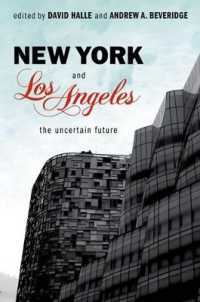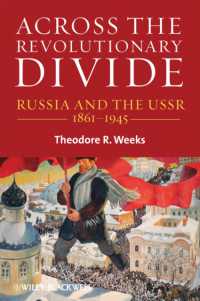- ホーム
- > 洋書
- > 英文書
- > Literary Criticism
Full Description
The poetics of epiphany have long been recognised as a broad aesthetic trend of modernism, related to the power of art to reveal the hidden essence of reality. Yet the critical use of the concept is still contested, complicated by the fact that in many modernist works exceptional moments are anything but revealing. This book embraces the blurred nature of epiphanies and sets out to explore their effects in a comparative journey paralleling Anglophone and Italian modernist short fiction. The work of four modernist short story writers - Luigi Pirandello, James Joyce, Federigo Tozzi, and Katherine Mansfield - illuminates epiphanies as complex phenomena, connected to multiple aspects of modernist culture, which appear in artistic experiences developed independently in the same decades. The ideas of Henri Bergson, William James, Martin Heidegger, and Maurice Merleau-Ponty, among others, nuance our understanding of the stories and of the author's vision behind them. At least three threads emerge, as a result, as common characteristics of modernist epiphanies. First, they are a result of the 'inward turn' and of the curiosity about the psyche's subconscious processes. Second, they attempt to rediscover lived experience as a source of partial but reliable knowledge. Third, they re-actualise mystical experiences as conduits to a secular insight about life. The main appeal of these modernist moments of enlightenment is precisely that they establish an atmosphere of ambiguity where multiple and sometimes irreconcilable potential meanings can be found. By so doing, they succeed in evoking the undifferentiated creative potential that, according to the widespread vitalist philosophies of the age, constitutes the essence of life. In reframing ambiguity and indeterminacy as spaces of creation and choice, epiphanies thus bring out a lesser known, life-affirming but not naïve vein of modernist inspiration.
Contents
Introduction: Understanding the Modernist Epiphany
I. Theories of the Modernist Epiphany
II. Literary Rendering
III. The Modernist Short Story
IV. Four Modernist Authors
References
1. 'A hole in the paper sky': Luigi Pirandello
1.1 Demystification
1.2 Metaphysical Intuition
1.3 Cosmic Consciousness
1.4 Blending the Opposites
1.5 Bifocal moments
References
2. 'The significance of trivial things': James Joyce
2.1 Aesthetic Theory
2.1.1 Whatness: quidditas as transcendence
2.1.2 Thisness: quidditas as immanence
2.2 Dubliners
2.3 Horizontal Depths
References
3. 'Behind a thick veil': Federigo Tozzi
3.1 Understated insights
3.2 Psyche as Mind
3.3 Psyche as Soul
3.4 Ambiguous Potential
References
4. 'The possibility of something quite other': Katherine Mansfield
4.1 Central Points of Significance
4.2 Moments of Direct Feeling
4.3 Moments of Suspension
4.4 Aesthetic Truth
References
Conclusions








